
Aari embroidery is a lovely and intricate kind of needlework that has been practiced for ages in India. Tambour embroidery is another name for it. The term “aari” refers to the hooked needle or awl used to produce the needlework.
Aari needlework dates back to the 12th century, when it was invented by leather craftsmen in the western Indian state of Gujarat. It was first used to beautify footwear, but it quickly spread to other textiles including silks and cottons.
During the Mughal era (16th-18th centuries), aari embroidery became fashionable. Mughal emperors were great supporters of the arts, commissioning aari embroiderers to produce magnificent and elaborate costumes for themselves and their court. Aari embroidery was also prominent during the British Raj (1858-1947), when the European aristocracy adopted it.
Aari needlework is still done in various places of India, particularly in Gujarat, Kashmir, and Kutch. It is also gaining popularity in other parts of the world as people recognize its beauty and precise craftsmanship.

Some of the essential characteristics of aari embroidery are as follows:
- It is a freehand embroidery technique, which means that the designs are not pre-printed on the fabric.
- It is done using a hooked needle or awl called an “aari”.
- The needle is threaded with a single strand of thread, which is then passed through the fabric and pulled back up, creating a chain stitch.
- The stitches are very small and close together, which creates a dense and intricate pattern.
- Aari embroidery can be used to create a variety of designs, including floral motifs, geometric patterns, and landscapes.
- It is often used to embellish clothing, home textiles, and accessories.
Aari embroidery is a lovely and adaptable kind of needlework with a long and illustrious history. It is still a skill practiced by artisans in many parts of India today, and it will undoubtedly remain popular for many years to come.

